Mobil Oil Australia Limited: Management of Change Report
VerifiedAdded on 2022/08/17
|18
|5450
|16
Report
AI Summary
This report delves into the complexities of change management, utilizing Mobil Oil Australia Limited (MOA) as a case study. It explores the implementation of a change project aimed at improving profitability and organizational culture. The report examines stakeholder management, analyzing how MOA addressed buy-in, resistance, and ethical considerations during the change process. It assesses the behaviors of change leaders, focusing on communication, adaptability, and ownership. The report further investigates organizational change models, comparing geocentric and global models, and discusses the significance of people management during radical shifts. It also touches upon appreciative inquiry and various intervention models. The analysis provides valuable insights into the challenges and successes of managing change within a large organization, highlighting the importance of effective leadership, stakeholder engagement, and adaptability.
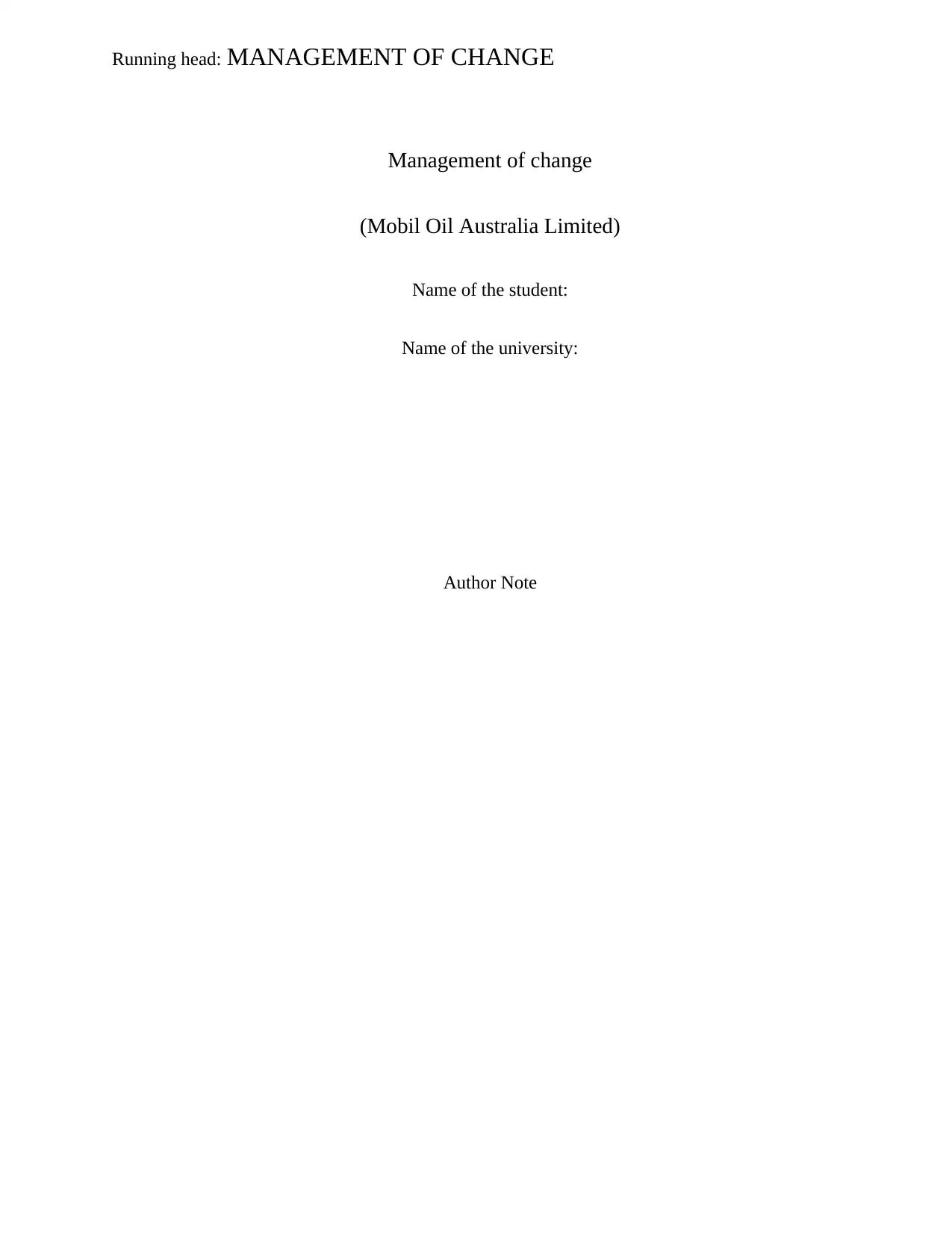
Running head: MANAGEMENT OF CHANGE
Management of change
(Mobil Oil Australia Limited)
Name of the student:
Name of the university:
Author Note
Management of change
(Mobil Oil Australia Limited)
Name of the student:
Name of the university:
Author Note
Paraphrase This Document
Need a fresh take? Get an instant paraphrase of this document with our AI Paraphraser
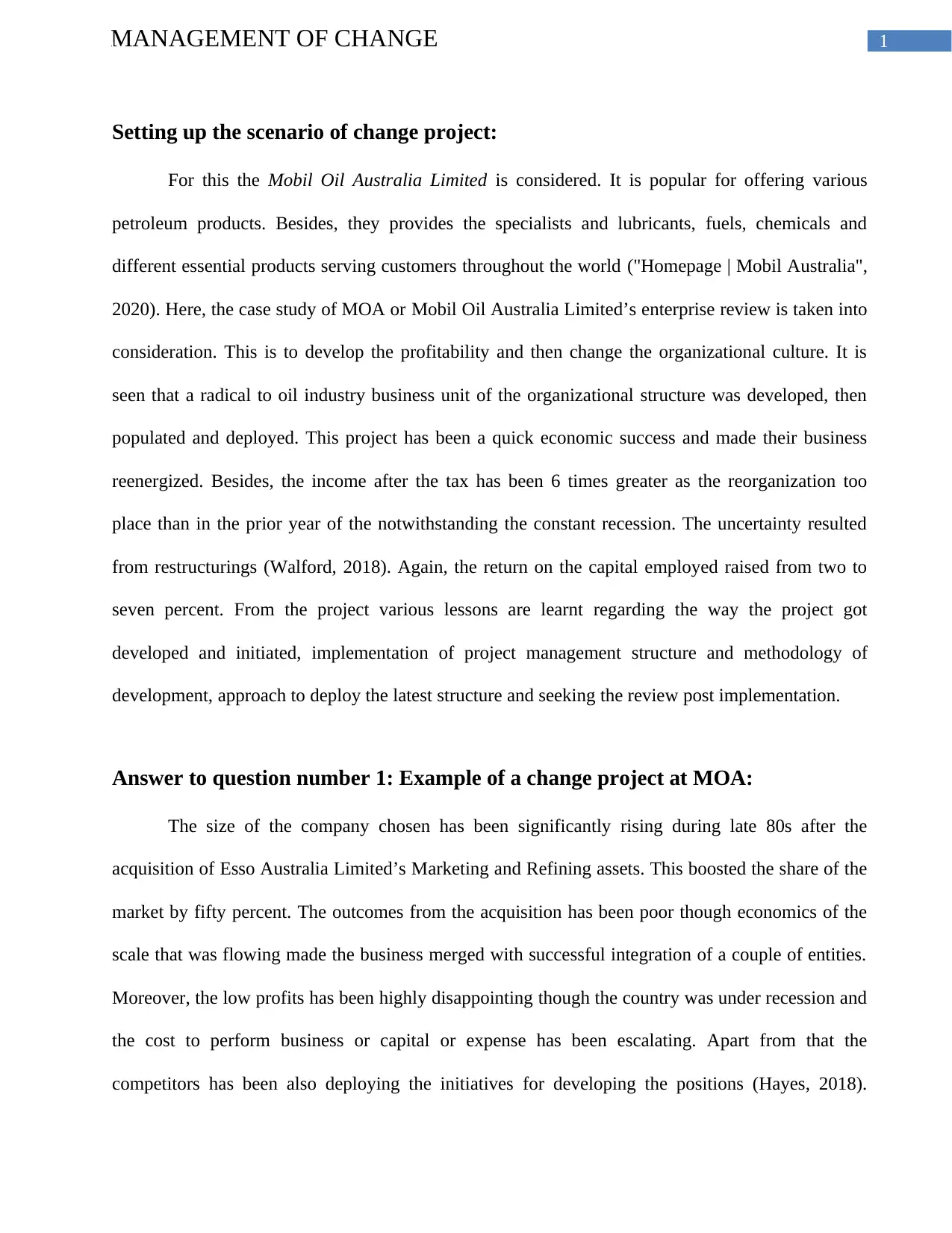
1MANAGEMENT OF CHANGE
Setting up the scenario of change project:
For this the Mobil Oil Australia Limited is considered. It is popular for offering various
petroleum products. Besides, they provides the specialists and lubricants, fuels, chemicals and
different essential products serving customers throughout the world ("Homepage | Mobil Australia",
2020). Here, the case study of MOA or Mobil Oil Australia Limited’s enterprise review is taken into
consideration. This is to develop the profitability and then change the organizational culture. It is
seen that a radical to oil industry business unit of the organizational structure was developed, then
populated and deployed. This project has been a quick economic success and made their business
reenergized. Besides, the income after the tax has been 6 times greater as the reorganization too
place than in the prior year of the notwithstanding the constant recession. The uncertainty resulted
from restructurings (Walford, 2018). Again, the return on the capital employed raised from two to
seven percent. From the project various lessons are learnt regarding the way the project got
developed and initiated, implementation of project management structure and methodology of
development, approach to deploy the latest structure and seeking the review post implementation.
Answer to question number 1: Example of a change project at MOA:
The size of the company chosen has been significantly rising during late 80s after the
acquisition of Esso Australia Limited’s Marketing and Refining assets. This boosted the share of the
market by fifty percent. The outcomes from the acquisition has been poor though economics of the
scale that was flowing made the business merged with successful integration of a couple of entities.
Moreover, the low profits has been highly disappointing though the country was under recession and
the cost to perform business or capital or expense has been escalating. Apart from that the
competitors has been also deploying the initiatives for developing the positions (Hayes, 2018).
Setting up the scenario of change project:
For this the Mobil Oil Australia Limited is considered. It is popular for offering various
petroleum products. Besides, they provides the specialists and lubricants, fuels, chemicals and
different essential products serving customers throughout the world ("Homepage | Mobil Australia",
2020). Here, the case study of MOA or Mobil Oil Australia Limited’s enterprise review is taken into
consideration. This is to develop the profitability and then change the organizational culture. It is
seen that a radical to oil industry business unit of the organizational structure was developed, then
populated and deployed. This project has been a quick economic success and made their business
reenergized. Besides, the income after the tax has been 6 times greater as the reorganization too
place than in the prior year of the notwithstanding the constant recession. The uncertainty resulted
from restructurings (Walford, 2018). Again, the return on the capital employed raised from two to
seven percent. From the project various lessons are learnt regarding the way the project got
developed and initiated, implementation of project management structure and methodology of
development, approach to deploy the latest structure and seeking the review post implementation.
Answer to question number 1: Example of a change project at MOA:
The size of the company chosen has been significantly rising during late 80s after the
acquisition of Esso Australia Limited’s Marketing and Refining assets. This boosted the share of the
market by fifty percent. The outcomes from the acquisition has been poor though economics of the
scale that was flowing made the business merged with successful integration of a couple of entities.
Moreover, the low profits has been highly disappointing though the country was under recession and
the cost to perform business or capital or expense has been escalating. Apart from that the
competitors has been also deploying the initiatives for developing the positions (Hayes, 2018).
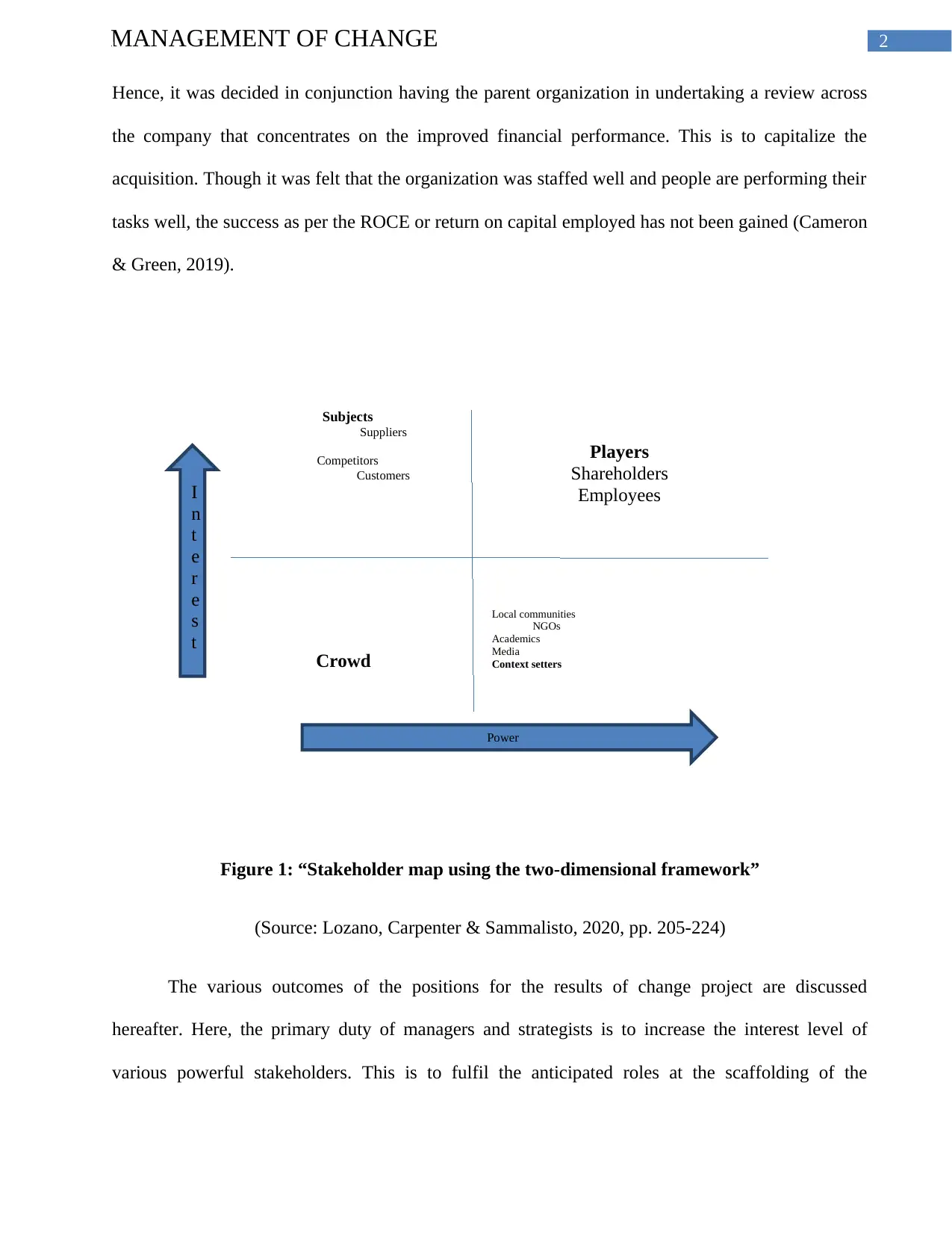
2MANAGEMENT OF CHANGE
I
n
t
e
r
e
s
t
Power
Subjects
Suppliers
Competitors
Customers
Players
Shareholders
Employees
Crowd
Local communities
NGOs
Academics
Media
Context setters
Hence, it was decided in conjunction having the parent organization in undertaking a review across
the company that concentrates on the improved financial performance. This is to capitalize the
acquisition. Though it was felt that the organization was staffed well and people are performing their
tasks well, the success as per the ROCE or return on capital employed has not been gained (Cameron
& Green, 2019).
Figure 1: “Stakeholder map using the two-dimensional framework”
(Source: Lozano, Carpenter & Sammalisto, 2020, pp. 205-224)
The various outcomes of the positions for the results of change project are discussed
hereafter. Here, the primary duty of managers and strategists is to increase the interest level of
various powerful stakeholders. This is to fulfil the anticipated roles at the scaffolding of the
I
n
t
e
r
e
s
t
Power
Subjects
Suppliers
Competitors
Customers
Players
Shareholders
Employees
Crowd
Local communities
NGOs
Academics
Media
Context setters
Hence, it was decided in conjunction having the parent organization in undertaking a review across
the company that concentrates on the improved financial performance. This is to capitalize the
acquisition. Though it was felt that the organization was staffed well and people are performing their
tasks well, the success as per the ROCE or return on capital employed has not been gained (Cameron
& Green, 2019).
Figure 1: “Stakeholder map using the two-dimensional framework”
(Source: Lozano, Carpenter & Sammalisto, 2020, pp. 205-224)
The various outcomes of the positions for the results of change project are discussed
hereafter. Here, the primary duty of managers and strategists is to increase the interest level of
various powerful stakeholders. This is to fulfil the anticipated roles at the scaffolding of the
⊘ This is a preview!⊘
Do you want full access?
Subscribe today to unlock all pages.

Trusted by 1+ million students worldwide
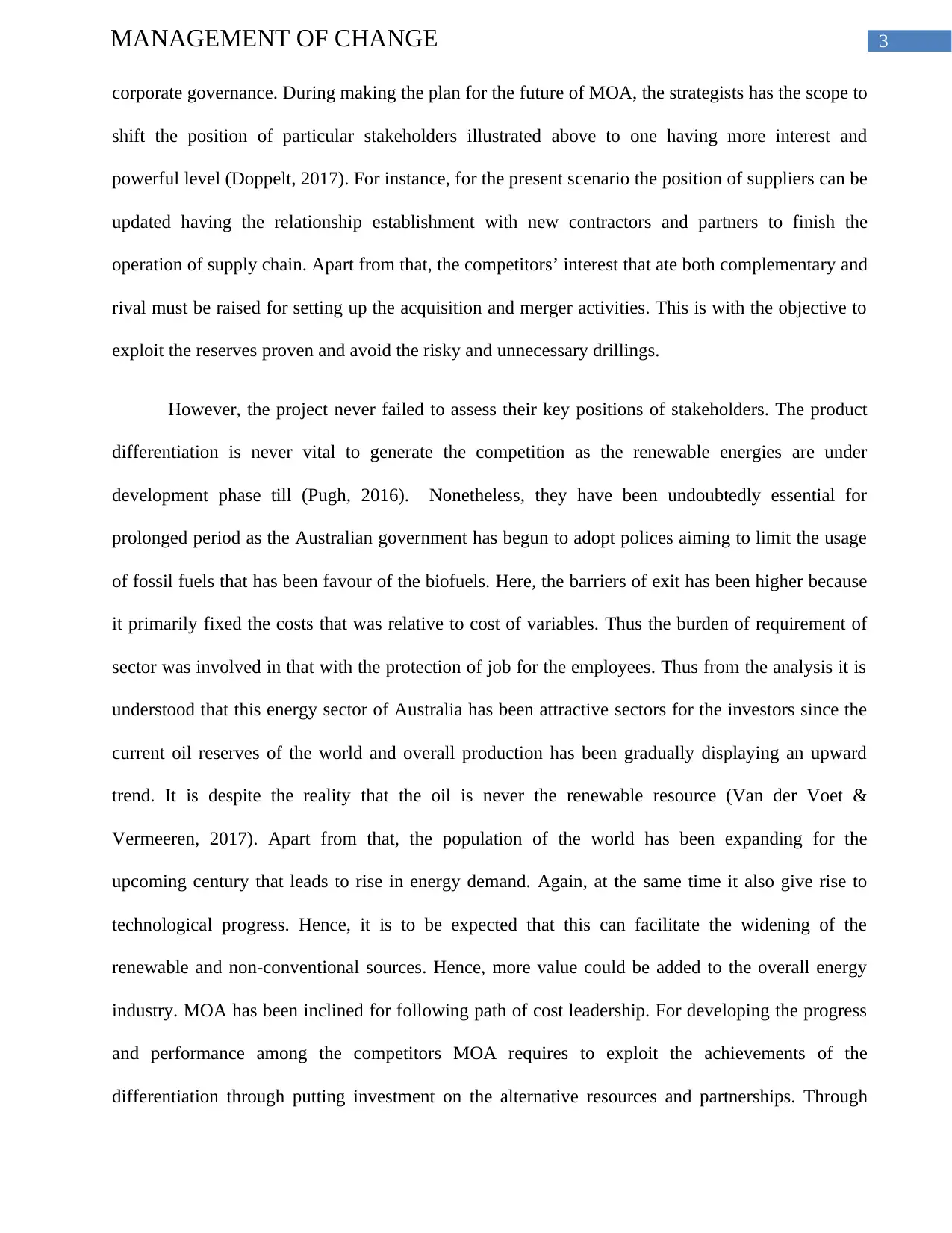
3MANAGEMENT OF CHANGE
corporate governance. During making the plan for the future of MOA, the strategists has the scope to
shift the position of particular stakeholders illustrated above to one having more interest and
powerful level (Doppelt, 2017). For instance, for the present scenario the position of suppliers can be
updated having the relationship establishment with new contractors and partners to finish the
operation of supply chain. Apart from that, the competitors’ interest that ate both complementary and
rival must be raised for setting up the acquisition and merger activities. This is with the objective to
exploit the reserves proven and avoid the risky and unnecessary drillings.
However, the project never failed to assess their key positions of stakeholders. The product
differentiation is never vital to generate the competition as the renewable energies are under
development phase till (Pugh, 2016). Nonetheless, they have been undoubtedly essential for
prolonged period as the Australian government has begun to adopt polices aiming to limit the usage
of fossil fuels that has been favour of the biofuels. Here, the barriers of exit has been higher because
it primarily fixed the costs that was relative to cost of variables. Thus the burden of requirement of
sector was involved in that with the protection of job for the employees. Thus from the analysis it is
understood that this energy sector of Australia has been attractive sectors for the investors since the
current oil reserves of the world and overall production has been gradually displaying an upward
trend. It is despite the reality that the oil is never the renewable resource (Van der Voet &
Vermeeren, 2017). Apart from that, the population of the world has been expanding for the
upcoming century that leads to rise in energy demand. Again, at the same time it also give rise to
technological progress. Hence, it is to be expected that this can facilitate the widening of the
renewable and non-conventional sources. Hence, more value could be added to the overall energy
industry. MOA has been inclined for following path of cost leadership. For developing the progress
and performance among the competitors MOA requires to exploit the achievements of the
differentiation through putting investment on the alternative resources and partnerships. Through
corporate governance. During making the plan for the future of MOA, the strategists has the scope to
shift the position of particular stakeholders illustrated above to one having more interest and
powerful level (Doppelt, 2017). For instance, for the present scenario the position of suppliers can be
updated having the relationship establishment with new contractors and partners to finish the
operation of supply chain. Apart from that, the competitors’ interest that ate both complementary and
rival must be raised for setting up the acquisition and merger activities. This is with the objective to
exploit the reserves proven and avoid the risky and unnecessary drillings.
However, the project never failed to assess their key positions of stakeholders. The product
differentiation is never vital to generate the competition as the renewable energies are under
development phase till (Pugh, 2016). Nonetheless, they have been undoubtedly essential for
prolonged period as the Australian government has begun to adopt polices aiming to limit the usage
of fossil fuels that has been favour of the biofuels. Here, the barriers of exit has been higher because
it primarily fixed the costs that was relative to cost of variables. Thus the burden of requirement of
sector was involved in that with the protection of job for the employees. Thus from the analysis it is
understood that this energy sector of Australia has been attractive sectors for the investors since the
current oil reserves of the world and overall production has been gradually displaying an upward
trend. It is despite the reality that the oil is never the renewable resource (Van der Voet &
Vermeeren, 2017). Apart from that, the population of the world has been expanding for the
upcoming century that leads to rise in energy demand. Again, at the same time it also give rise to
technological progress. Hence, it is to be expected that this can facilitate the widening of the
renewable and non-conventional sources. Hence, more value could be added to the overall energy
industry. MOA has been inclined for following path of cost leadership. For developing the progress
and performance among the competitors MOA requires to exploit the achievements of the
differentiation through putting investment on the alternative resources and partnerships. Through
Paraphrase This Document
Need a fresh take? Get an instant paraphrase of this document with our AI Paraphraser
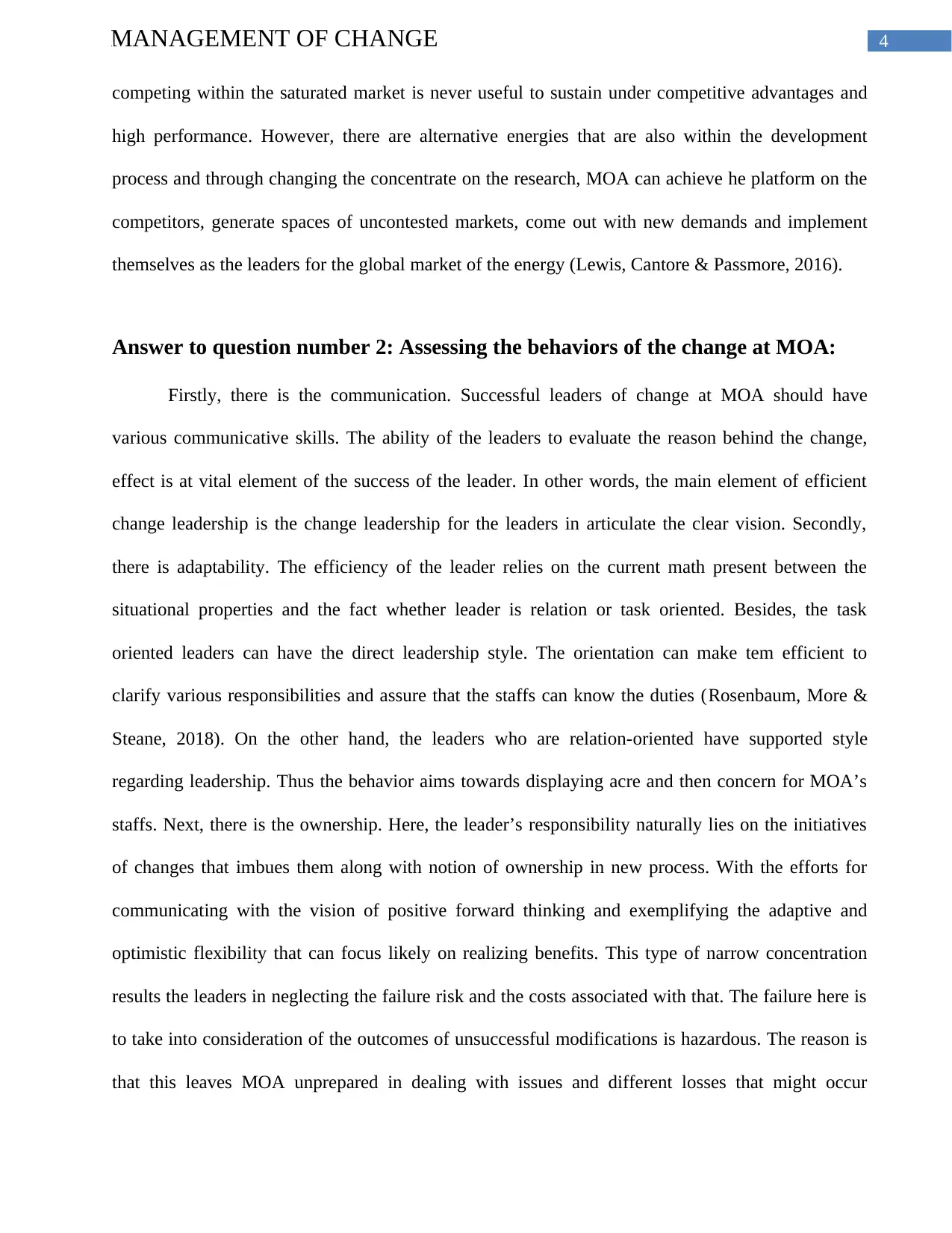
4MANAGEMENT OF CHANGE
competing within the saturated market is never useful to sustain under competitive advantages and
high performance. However, there are alternative energies that are also within the development
process and through changing the concentrate on the research, MOA can achieve he platform on the
competitors, generate spaces of uncontested markets, come out with new demands and implement
themselves as the leaders for the global market of the energy (Lewis, Cantore & Passmore, 2016).
Answer to question number 2: Assessing the behaviors of the change at MOA:
Firstly, there is the communication. Successful leaders of change at MOA should have
various communicative skills. The ability of the leaders to evaluate the reason behind the change,
effect is at vital element of the success of the leader. In other words, the main element of efficient
change leadership is the change leadership for the leaders in articulate the clear vision. Secondly,
there is adaptability. The efficiency of the leader relies on the current math present between the
situational properties and the fact whether leader is relation or task oriented. Besides, the task
oriented leaders can have the direct leadership style. The orientation can make tem efficient to
clarify various responsibilities and assure that the staffs can know the duties (Rosenbaum, More &
Steane, 2018). On the other hand, the leaders who are relation-oriented have supported style
regarding leadership. Thus the behavior aims towards displaying acre and then concern for MOA’s
staffs. Next, there is the ownership. Here, the leader’s responsibility naturally lies on the initiatives
of changes that imbues them along with notion of ownership in new process. With the efforts for
communicating with the vision of positive forward thinking and exemplifying the adaptive and
optimistic flexibility that can focus likely on realizing benefits. This type of narrow concentration
results the leaders in neglecting the failure risk and the costs associated with that. The failure here is
to take into consideration of the outcomes of unsuccessful modifications is hazardous. The reason is
that this leaves MOA unprepared in dealing with issues and different losses that might occur
competing within the saturated market is never useful to sustain under competitive advantages and
high performance. However, there are alternative energies that are also within the development
process and through changing the concentrate on the research, MOA can achieve he platform on the
competitors, generate spaces of uncontested markets, come out with new demands and implement
themselves as the leaders for the global market of the energy (Lewis, Cantore & Passmore, 2016).
Answer to question number 2: Assessing the behaviors of the change at MOA:
Firstly, there is the communication. Successful leaders of change at MOA should have
various communicative skills. The ability of the leaders to evaluate the reason behind the change,
effect is at vital element of the success of the leader. In other words, the main element of efficient
change leadership is the change leadership for the leaders in articulate the clear vision. Secondly,
there is adaptability. The efficiency of the leader relies on the current math present between the
situational properties and the fact whether leader is relation or task oriented. Besides, the task
oriented leaders can have the direct leadership style. The orientation can make tem efficient to
clarify various responsibilities and assure that the staffs can know the duties (Rosenbaum, More &
Steane, 2018). On the other hand, the leaders who are relation-oriented have supported style
regarding leadership. Thus the behavior aims towards displaying acre and then concern for MOA’s
staffs. Next, there is the ownership. Here, the leader’s responsibility naturally lies on the initiatives
of changes that imbues them along with notion of ownership in new process. With the efforts for
communicating with the vision of positive forward thinking and exemplifying the adaptive and
optimistic flexibility that can focus likely on realizing benefits. This type of narrow concentration
results the leaders in neglecting the failure risk and the costs associated with that. The failure here is
to take into consideration of the outcomes of unsuccessful modifications is hazardous. The reason is
that this leaves MOA unprepared in dealing with issues and different losses that might occur
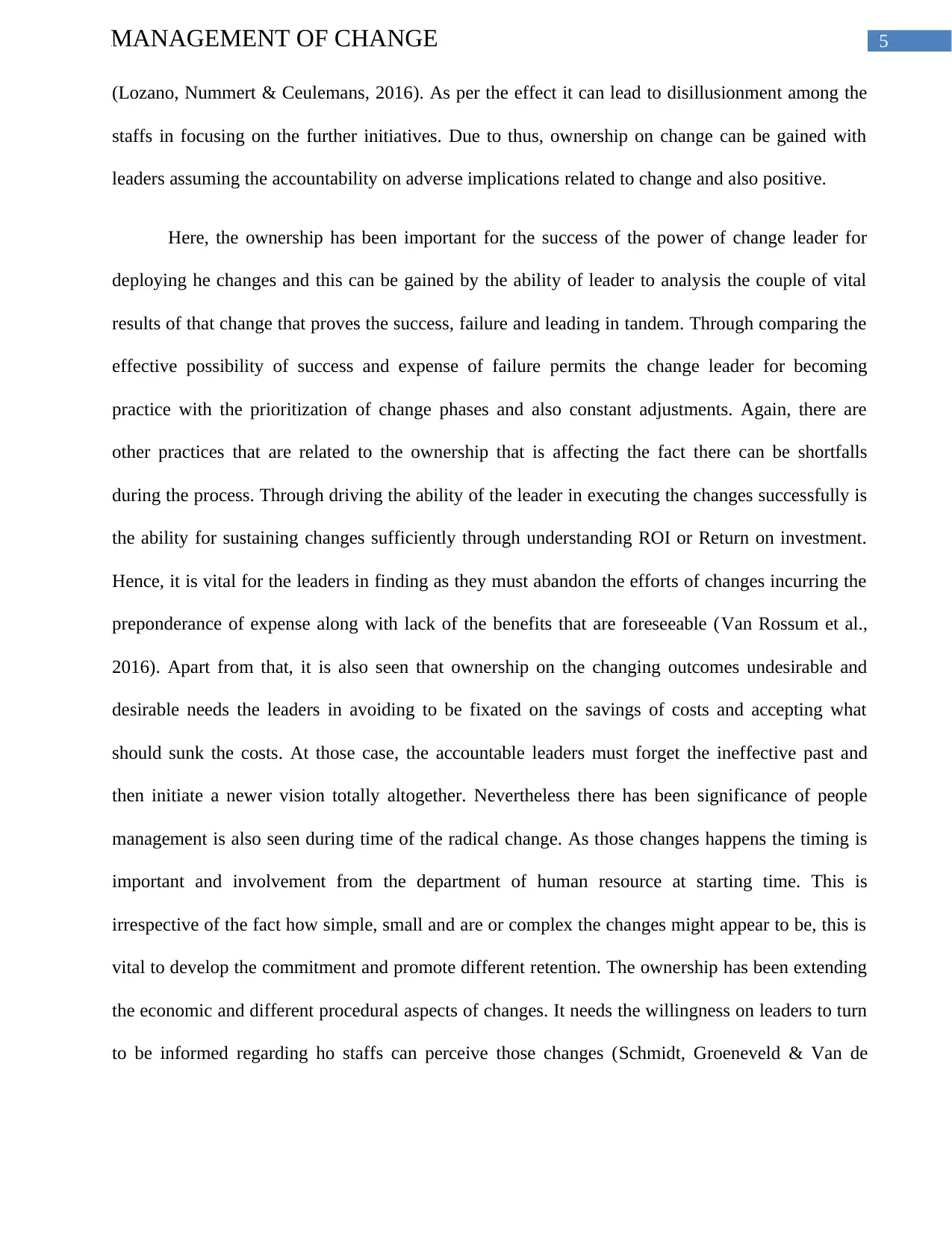
5MANAGEMENT OF CHANGE
(Lozano, Nummert & Ceulemans, 2016). As per the effect it can lead to disillusionment among the
staffs in focusing on the further initiatives. Due to thus, ownership on change can be gained with
leaders assuming the accountability on adverse implications related to change and also positive.
Here, the ownership has been important for the success of the power of change leader for
deploying he changes and this can be gained by the ability of leader to analysis the couple of vital
results of that change that proves the success, failure and leading in tandem. Through comparing the
effective possibility of success and expense of failure permits the change leader for becoming
practice with the prioritization of change phases and also constant adjustments. Again, there are
other practices that are related to the ownership that is affecting the fact there can be shortfalls
during the process. Through driving the ability of the leader in executing the changes successfully is
the ability for sustaining changes sufficiently through understanding ROI or Return on investment.
Hence, it is vital for the leaders in finding as they must abandon the efforts of changes incurring the
preponderance of expense along with lack of the benefits that are foreseeable (Van Rossum et al.,
2016). Apart from that, it is also seen that ownership on the changing outcomes undesirable and
desirable needs the leaders in avoiding to be fixated on the savings of costs and accepting what
should sunk the costs. At those case, the accountable leaders must forget the ineffective past and
then initiate a newer vision totally altogether. Nevertheless there has been significance of people
management is also seen during time of the radical change. As those changes happens the timing is
important and involvement from the department of human resource at starting time. This is
irrespective of the fact how simple, small and are or complex the changes might appear to be, this is
vital to develop the commitment and promote different retention. The ownership has been extending
the economic and different procedural aspects of changes. It needs the willingness on leaders to turn
to be informed regarding ho staffs can perceive those changes (Schmidt, Groeneveld & Van de
(Lozano, Nummert & Ceulemans, 2016). As per the effect it can lead to disillusionment among the
staffs in focusing on the further initiatives. Due to thus, ownership on change can be gained with
leaders assuming the accountability on adverse implications related to change and also positive.
Here, the ownership has been important for the success of the power of change leader for
deploying he changes and this can be gained by the ability of leader to analysis the couple of vital
results of that change that proves the success, failure and leading in tandem. Through comparing the
effective possibility of success and expense of failure permits the change leader for becoming
practice with the prioritization of change phases and also constant adjustments. Again, there are
other practices that are related to the ownership that is affecting the fact there can be shortfalls
during the process. Through driving the ability of the leader in executing the changes successfully is
the ability for sustaining changes sufficiently through understanding ROI or Return on investment.
Hence, it is vital for the leaders in finding as they must abandon the efforts of changes incurring the
preponderance of expense along with lack of the benefits that are foreseeable (Van Rossum et al.,
2016). Apart from that, it is also seen that ownership on the changing outcomes undesirable and
desirable needs the leaders in avoiding to be fixated on the savings of costs and accepting what
should sunk the costs. At those case, the accountable leaders must forget the ineffective past and
then initiate a newer vision totally altogether. Nevertheless there has been significance of people
management is also seen during time of the radical change. As those changes happens the timing is
important and involvement from the department of human resource at starting time. This is
irrespective of the fact how simple, small and are or complex the changes might appear to be, this is
vital to develop the commitment and promote different retention. The ownership has been extending
the economic and different procedural aspects of changes. It needs the willingness on leaders to turn
to be informed regarding ho staffs can perceive those changes (Schmidt, Groeneveld & Van de
⊘ This is a preview!⊘
Do you want full access?
Subscribe today to unlock all pages.

Trusted by 1+ million students worldwide
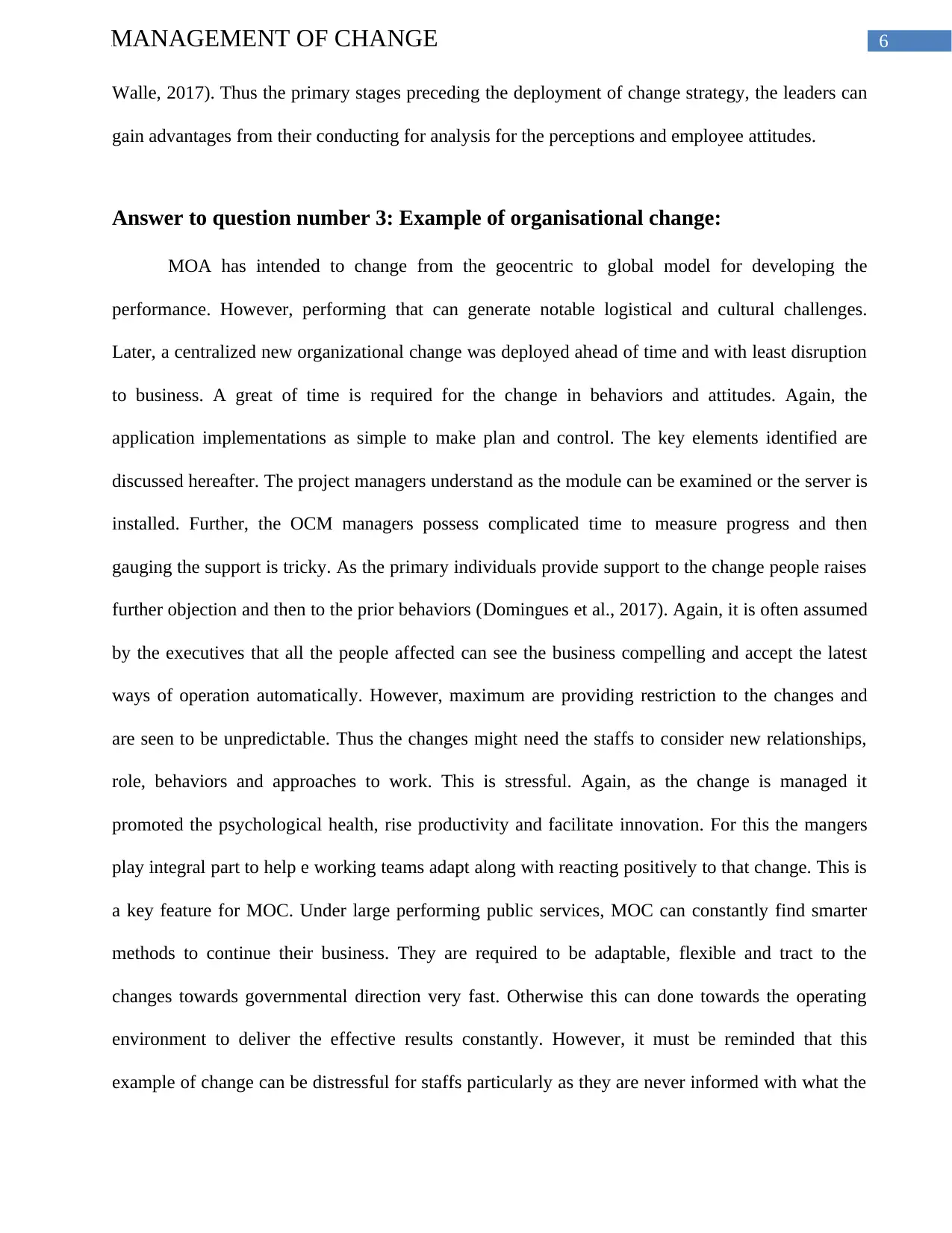
6MANAGEMENT OF CHANGE
Walle, 2017). Thus the primary stages preceding the deployment of change strategy, the leaders can
gain advantages from their conducting for analysis for the perceptions and employee attitudes.
Answer to question number 3: Example of organisational change:
MOA has intended to change from the geocentric to global model for developing the
performance. However, performing that can generate notable logistical and cultural challenges.
Later, a centralized new organizational change was deployed ahead of time and with least disruption
to business. A great of time is required for the change in behaviors and attitudes. Again, the
application implementations as simple to make plan and control. The key elements identified are
discussed hereafter. The project managers understand as the module can be examined or the server is
installed. Further, the OCM managers possess complicated time to measure progress and then
gauging the support is tricky. As the primary individuals provide support to the change people raises
further objection and then to the prior behaviors (Domingues et al., 2017). Again, it is often assumed
by the executives that all the people affected can see the business compelling and accept the latest
ways of operation automatically. However, maximum are providing restriction to the changes and
are seen to be unpredictable. Thus the changes might need the staffs to consider new relationships,
role, behaviors and approaches to work. This is stressful. Again, as the change is managed it
promoted the psychological health, rise productivity and facilitate innovation. For this the mangers
play integral part to help e working teams adapt along with reacting positively to that change. This is
a key feature for MOC. Under large performing public services, MOC can constantly find smarter
methods to continue their business. They are required to be adaptable, flexible and tract to the
changes towards governmental direction very fast. Otherwise this can done towards the operating
environment to deliver the effective results constantly. However, it must be reminded that this
example of change can be distressful for staffs particularly as they are never informed with what the
Walle, 2017). Thus the primary stages preceding the deployment of change strategy, the leaders can
gain advantages from their conducting for analysis for the perceptions and employee attitudes.
Answer to question number 3: Example of organisational change:
MOA has intended to change from the geocentric to global model for developing the
performance. However, performing that can generate notable logistical and cultural challenges.
Later, a centralized new organizational change was deployed ahead of time and with least disruption
to business. A great of time is required for the change in behaviors and attitudes. Again, the
application implementations as simple to make plan and control. The key elements identified are
discussed hereafter. The project managers understand as the module can be examined or the server is
installed. Further, the OCM managers possess complicated time to measure progress and then
gauging the support is tricky. As the primary individuals provide support to the change people raises
further objection and then to the prior behaviors (Domingues et al., 2017). Again, it is often assumed
by the executives that all the people affected can see the business compelling and accept the latest
ways of operation automatically. However, maximum are providing restriction to the changes and
are seen to be unpredictable. Thus the changes might need the staffs to consider new relationships,
role, behaviors and approaches to work. This is stressful. Again, as the change is managed it
promoted the psychological health, rise productivity and facilitate innovation. For this the mangers
play integral part to help e working teams adapt along with reacting positively to that change. This is
a key feature for MOC. Under large performing public services, MOC can constantly find smarter
methods to continue their business. They are required to be adaptable, flexible and tract to the
changes towards governmental direction very fast. Otherwise this can done towards the operating
environment to deliver the effective results constantly. However, it must be reminded that this
example of change can be distressful for staffs particularly as they are never informed with what the
Paraphrase This Document
Need a fresh take? Get an instant paraphrase of this document with our AI Paraphraser
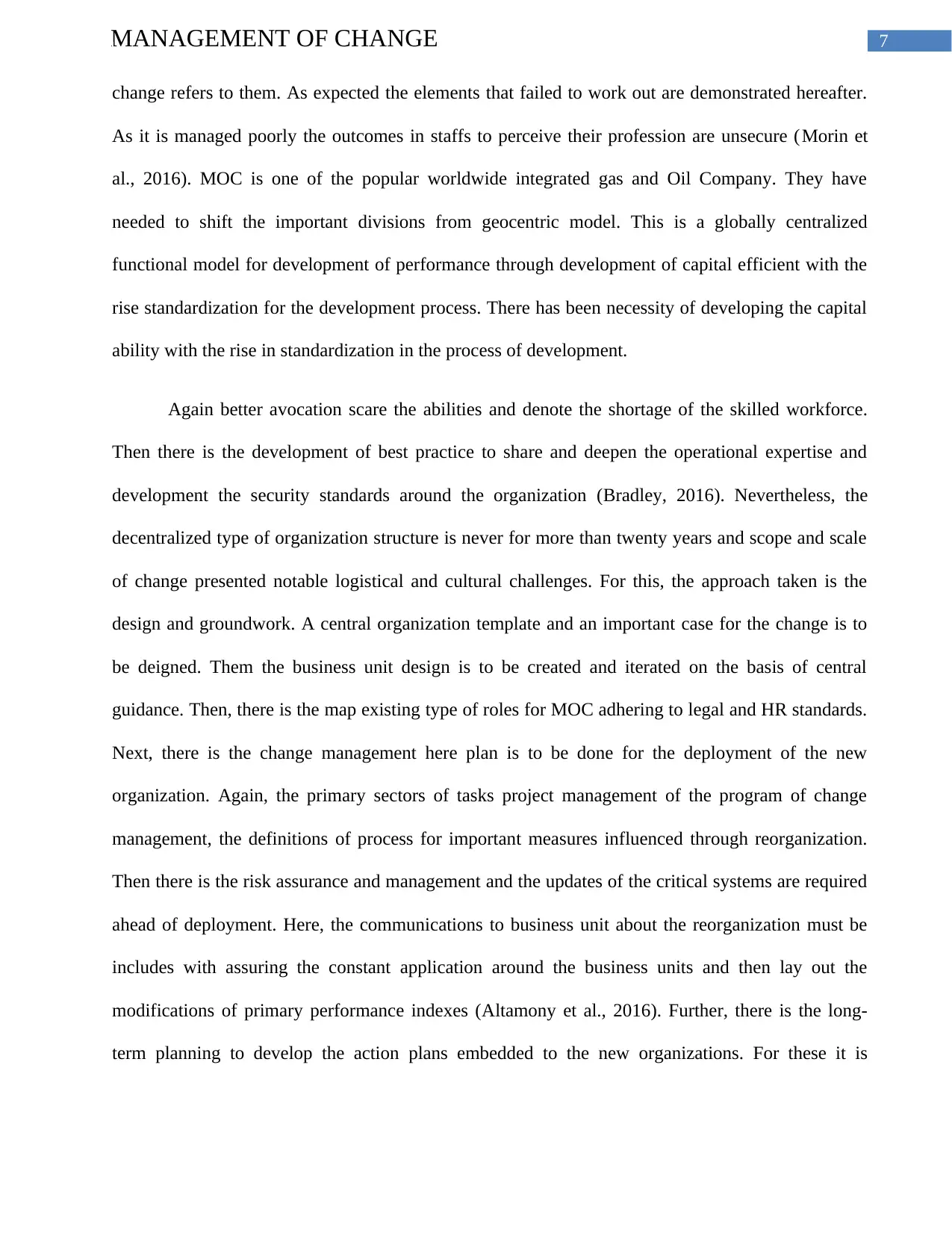
7MANAGEMENT OF CHANGE
change refers to them. As expected the elements that failed to work out are demonstrated hereafter.
As it is managed poorly the outcomes in staffs to perceive their profession are unsecure (Morin et
al., 2016). MOC is one of the popular worldwide integrated gas and Oil Company. They have
needed to shift the important divisions from geocentric model. This is a globally centralized
functional model for development of performance through development of capital efficient with the
rise standardization for the development process. There has been necessity of developing the capital
ability with the rise in standardization in the process of development.
Again better avocation scare the abilities and denote the shortage of the skilled workforce.
Then there is the development of best practice to share and deepen the operational expertise and
development the security standards around the organization (Bradley, 2016). Nevertheless, the
decentralized type of organization structure is never for more than twenty years and scope and scale
of change presented notable logistical and cultural challenges. For this, the approach taken is the
design and groundwork. A central organization template and an important case for the change is to
be deigned. Them the business unit design is to be created and iterated on the basis of central
guidance. Then, there is the map existing type of roles for MOC adhering to legal and HR standards.
Next, there is the change management here plan is to be done for the deployment of the new
organization. Again, the primary sectors of tasks project management of the program of change
management, the definitions of process for important measures influenced through reorganization.
Then there is the risk assurance and management and the updates of the critical systems are required
ahead of deployment. Here, the communications to business unit about the reorganization must be
includes with assuring the constant application around the business units and then lay out the
modifications of primary performance indexes (Altamony et al., 2016). Further, there is the long-
term planning to develop the action plans embedded to the new organizations. For these it is
change refers to them. As expected the elements that failed to work out are demonstrated hereafter.
As it is managed poorly the outcomes in staffs to perceive their profession are unsecure (Morin et
al., 2016). MOC is one of the popular worldwide integrated gas and Oil Company. They have
needed to shift the important divisions from geocentric model. This is a globally centralized
functional model for development of performance through development of capital efficient with the
rise standardization for the development process. There has been necessity of developing the capital
ability with the rise in standardization in the process of development.
Again better avocation scare the abilities and denote the shortage of the skilled workforce.
Then there is the development of best practice to share and deepen the operational expertise and
development the security standards around the organization (Bradley, 2016). Nevertheless, the
decentralized type of organization structure is never for more than twenty years and scope and scale
of change presented notable logistical and cultural challenges. For this, the approach taken is the
design and groundwork. A central organization template and an important case for the change is to
be deigned. Them the business unit design is to be created and iterated on the basis of central
guidance. Then, there is the map existing type of roles for MOC adhering to legal and HR standards.
Next, there is the change management here plan is to be done for the deployment of the new
organization. Again, the primary sectors of tasks project management of the program of change
management, the definitions of process for important measures influenced through reorganization.
Then there is the risk assurance and management and the updates of the critical systems are required
ahead of deployment. Here, the communications to business unit about the reorganization must be
includes with assuring the constant application around the business units and then lay out the
modifications of primary performance indexes (Altamony et al., 2016). Further, there is the long-
term planning to develop the action plans embedded to the new organizations. For these it is
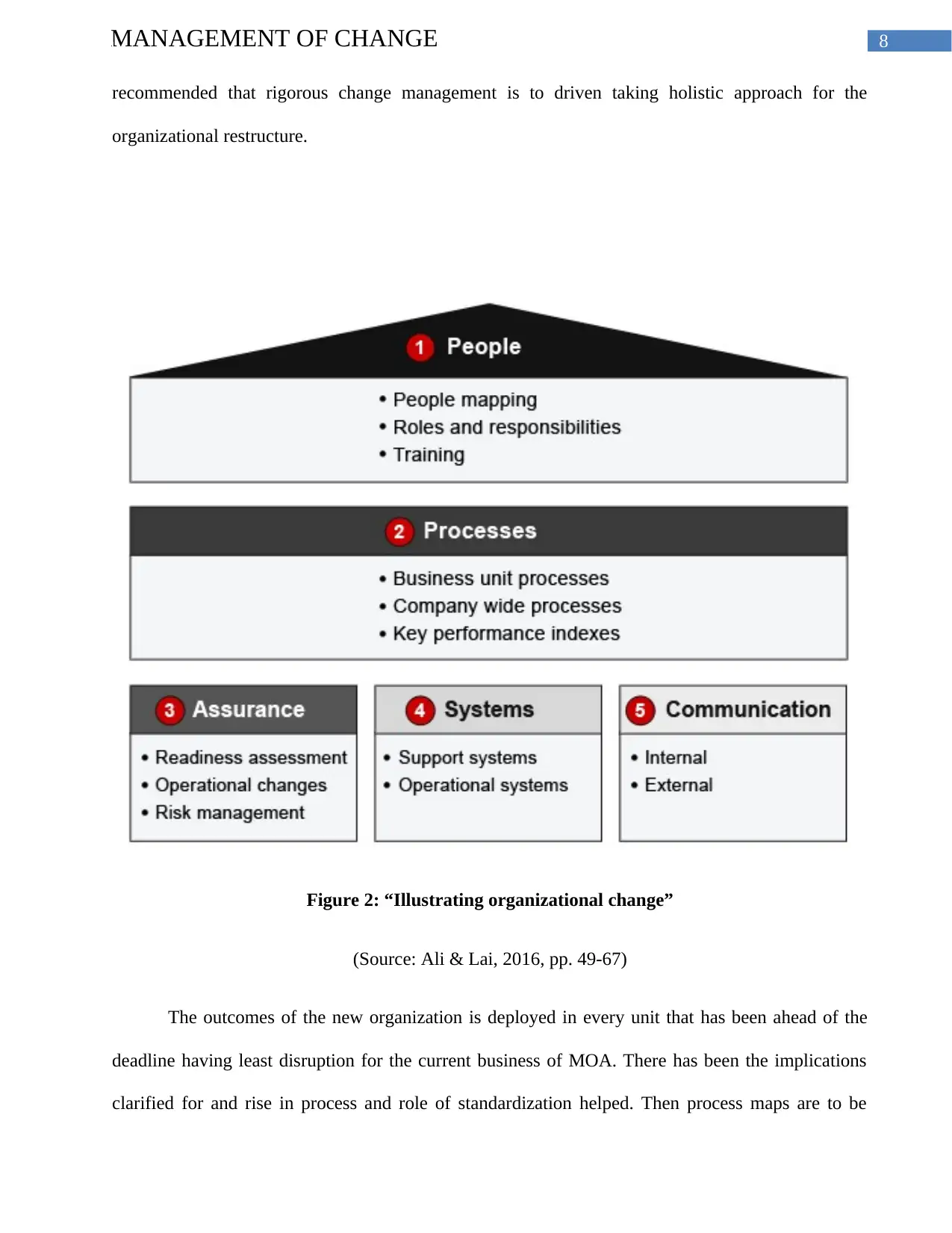
8MANAGEMENT OF CHANGE
recommended that rigorous change management is to driven taking holistic approach for the
organizational restructure.
Figure 2: “Illustrating organizational change”
(Source: Ali & Lai, 2016, pp. 49-67)
The outcomes of the new organization is deployed in every unit that has been ahead of the
deadline having least disruption for the current business of MOA. There has been the implications
clarified for and rise in process and role of standardization helped. Then process maps are to be
recommended that rigorous change management is to driven taking holistic approach for the
organizational restructure.
Figure 2: “Illustrating organizational change”
(Source: Ali & Lai, 2016, pp. 49-67)
The outcomes of the new organization is deployed in every unit that has been ahead of the
deadline having least disruption for the current business of MOA. There has been the implications
clarified for and rise in process and role of standardization helped. Then process maps are to be
⊘ This is a preview!⊘
Do you want full access?
Subscribe today to unlock all pages.

Trusted by 1+ million students worldwide
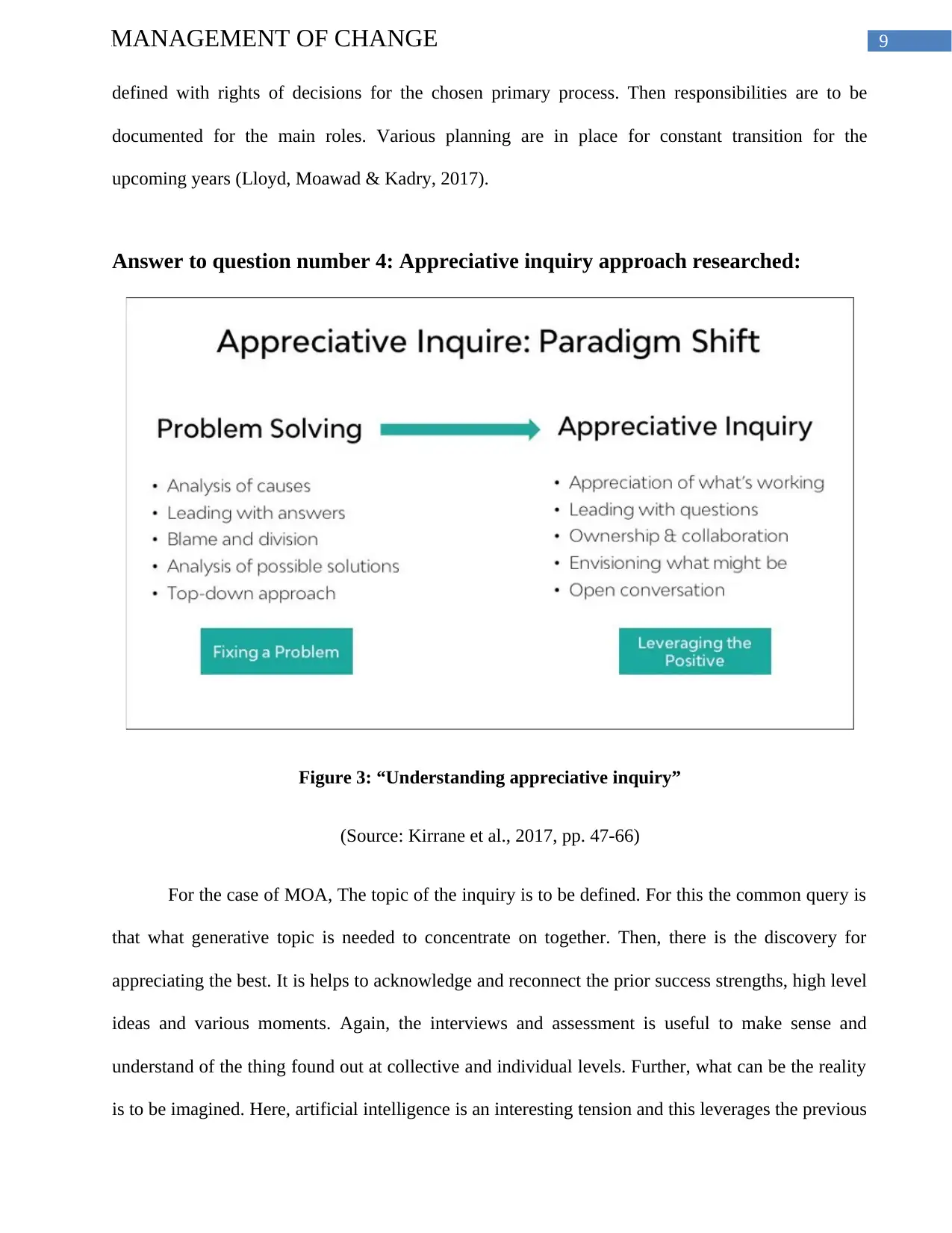
9MANAGEMENT OF CHANGE
defined with rights of decisions for the chosen primary process. Then responsibilities are to be
documented for the main roles. Various planning are in place for constant transition for the
upcoming years (Lloyd, Moawad & Kadry, 2017).
Answer to question number 4: Appreciative inquiry approach researched:
Figure 3: “Understanding appreciative inquiry”
(Source: Kirrane et al., 2017, pp. 47-66)
For the case of MOA, The topic of the inquiry is to be defined. For this the common query is
that what generative topic is needed to concentrate on together. Then, there is the discovery for
appreciating the best. It is helps to acknowledge and reconnect the prior success strengths, high level
ideas and various moments. Again, the interviews and assessment is useful to make sense and
understand of the thing found out at collective and individual levels. Further, what can be the reality
is to be imagined. Here, artificial intelligence is an interesting tension and this leverages the previous
defined with rights of decisions for the chosen primary process. Then responsibilities are to be
documented for the main roles. Various planning are in place for constant transition for the
upcoming years (Lloyd, Moawad & Kadry, 2017).
Answer to question number 4: Appreciative inquiry approach researched:
Figure 3: “Understanding appreciative inquiry”
(Source: Kirrane et al., 2017, pp. 47-66)
For the case of MOA, The topic of the inquiry is to be defined. For this the common query is
that what generative topic is needed to concentrate on together. Then, there is the discovery for
appreciating the best. It is helps to acknowledge and reconnect the prior success strengths, high level
ideas and various moments. Again, the interviews and assessment is useful to make sense and
understand of the thing found out at collective and individual levels. Further, what can be the reality
is to be imagined. Here, artificial intelligence is an interesting tension and this leverages the previous
Paraphrase This Document
Need a fresh take? Get an instant paraphrase of this document with our AI Paraphraser
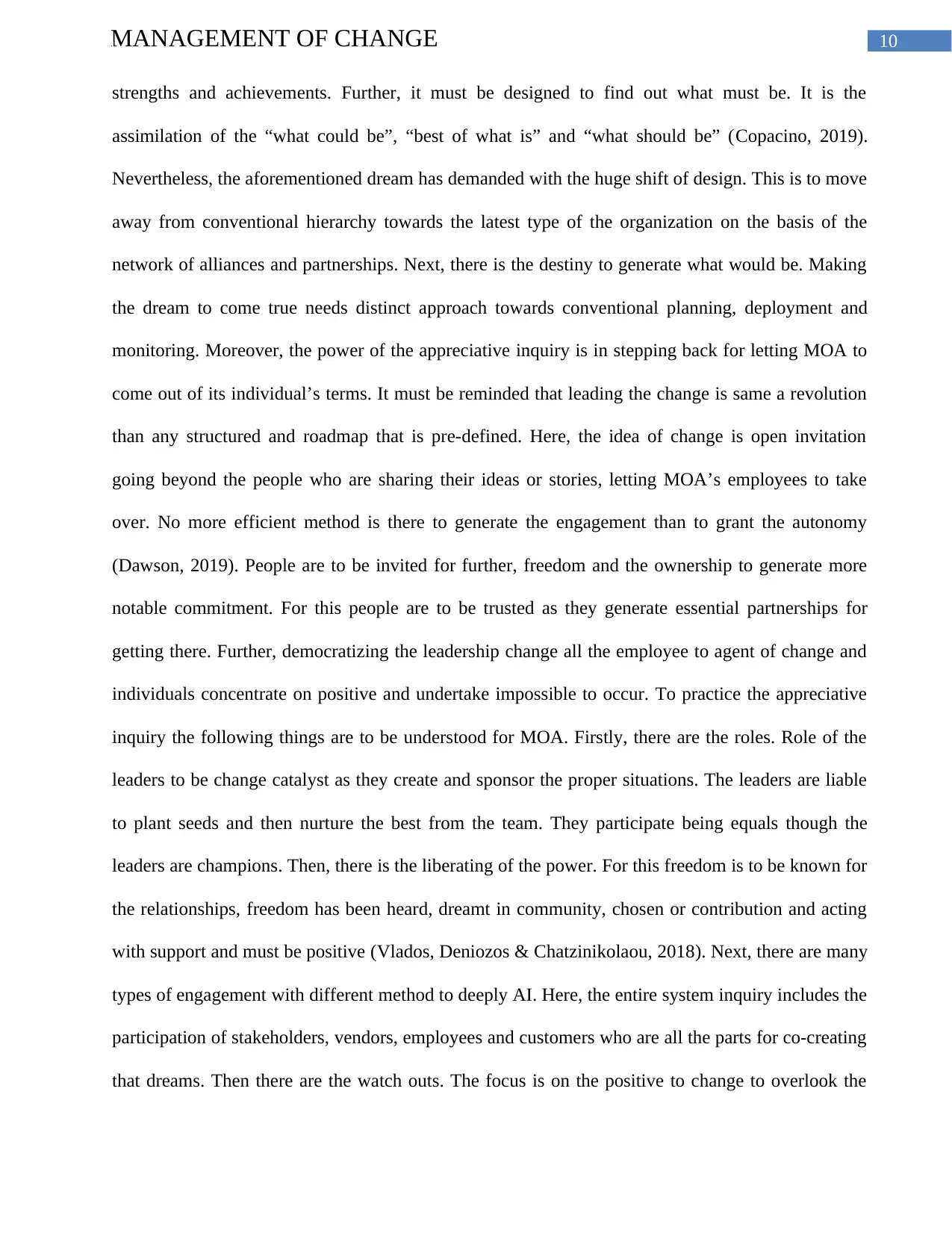
10MANAGEMENT OF CHANGE
strengths and achievements. Further, it must be designed to find out what must be. It is the
assimilation of the “what could be”, “best of what is” and “what should be” (Copacino, 2019).
Nevertheless, the aforementioned dream has demanded with the huge shift of design. This is to move
away from conventional hierarchy towards the latest type of the organization on the basis of the
network of alliances and partnerships. Next, there is the destiny to generate what would be. Making
the dream to come true needs distinct approach towards conventional planning, deployment and
monitoring. Moreover, the power of the appreciative inquiry is in stepping back for letting MOA to
come out of its individual’s terms. It must be reminded that leading the change is same a revolution
than any structured and roadmap that is pre-defined. Here, the idea of change is open invitation
going beyond the people who are sharing their ideas or stories, letting MOA’s employees to take
over. No more efficient method is there to generate the engagement than to grant the autonomy
(Dawson, 2019). People are to be invited for further, freedom and the ownership to generate more
notable commitment. For this people are to be trusted as they generate essential partnerships for
getting there. Further, democratizing the leadership change all the employee to agent of change and
individuals concentrate on positive and undertake impossible to occur. To practice the appreciative
inquiry the following things are to be understood for MOA. Firstly, there are the roles. Role of the
leaders to be change catalyst as they create and sponsor the proper situations. The leaders are liable
to plant seeds and then nurture the best from the team. They participate being equals though the
leaders are champions. Then, there is the liberating of the power. For this freedom is to be known for
the relationships, freedom has been heard, dreamt in community, chosen or contribution and acting
with support and must be positive (Vlados, Deniozos & Chatzinikolaou, 2018). Next, there are many
types of engagement with different method to deeply AI. Here, the entire system inquiry includes the
participation of stakeholders, vendors, employees and customers who are all the parts for co-creating
that dreams. Then there are the watch outs. The focus is on the positive to change to overlook the
strengths and achievements. Further, it must be designed to find out what must be. It is the
assimilation of the “what could be”, “best of what is” and “what should be” (Copacino, 2019).
Nevertheless, the aforementioned dream has demanded with the huge shift of design. This is to move
away from conventional hierarchy towards the latest type of the organization on the basis of the
network of alliances and partnerships. Next, there is the destiny to generate what would be. Making
the dream to come true needs distinct approach towards conventional planning, deployment and
monitoring. Moreover, the power of the appreciative inquiry is in stepping back for letting MOA to
come out of its individual’s terms. It must be reminded that leading the change is same a revolution
than any structured and roadmap that is pre-defined. Here, the idea of change is open invitation
going beyond the people who are sharing their ideas or stories, letting MOA’s employees to take
over. No more efficient method is there to generate the engagement than to grant the autonomy
(Dawson, 2019). People are to be invited for further, freedom and the ownership to generate more
notable commitment. For this people are to be trusted as they generate essential partnerships for
getting there. Further, democratizing the leadership change all the employee to agent of change and
individuals concentrate on positive and undertake impossible to occur. To practice the appreciative
inquiry the following things are to be understood for MOA. Firstly, there are the roles. Role of the
leaders to be change catalyst as they create and sponsor the proper situations. The leaders are liable
to plant seeds and then nurture the best from the team. They participate being equals though the
leaders are champions. Then, there is the liberating of the power. For this freedom is to be known for
the relationships, freedom has been heard, dreamt in community, chosen or contribution and acting
with support and must be positive (Vlados, Deniozos & Chatzinikolaou, 2018). Next, there are many
types of engagement with different method to deeply AI. Here, the entire system inquiry includes the
participation of stakeholders, vendors, employees and customers who are all the parts for co-creating
that dreams. Then there are the watch outs. The focus is on the positive to change to overlook the
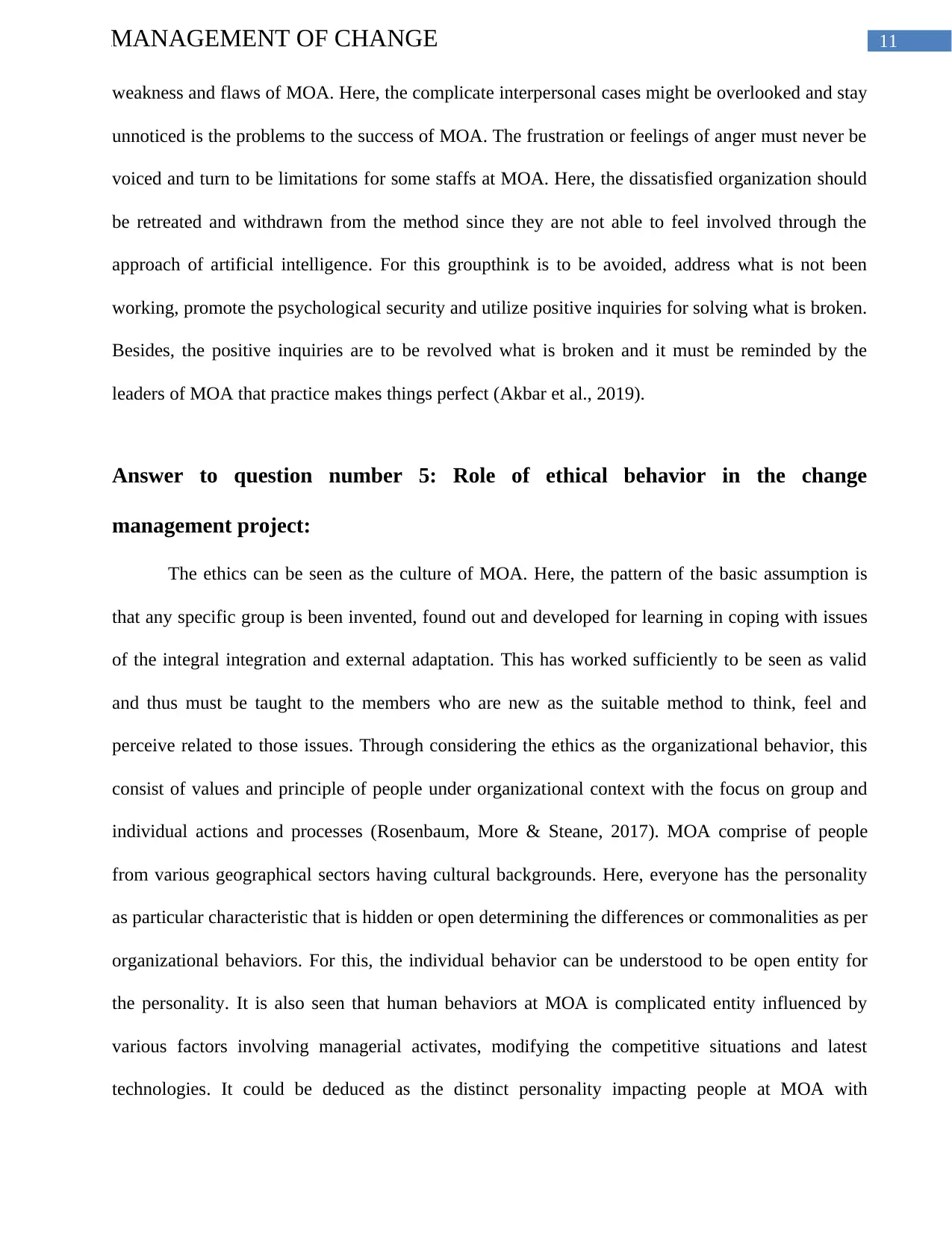
11MANAGEMENT OF CHANGE
weakness and flaws of MOA. Here, the complicate interpersonal cases might be overlooked and stay
unnoticed is the problems to the success of MOA. The frustration or feelings of anger must never be
voiced and turn to be limitations for some staffs at MOA. Here, the dissatisfied organization should
be retreated and withdrawn from the method since they are not able to feel involved through the
approach of artificial intelligence. For this groupthink is to be avoided, address what is not been
working, promote the psychological security and utilize positive inquiries for solving what is broken.
Besides, the positive inquiries are to be revolved what is broken and it must be reminded by the
leaders of MOA that practice makes things perfect (Akbar et al., 2019).
Answer to question number 5: Role of ethical behavior in the change
management project:
The ethics can be seen as the culture of MOA. Here, the pattern of the basic assumption is
that any specific group is been invented, found out and developed for learning in coping with issues
of the integral integration and external adaptation. This has worked sufficiently to be seen as valid
and thus must be taught to the members who are new as the suitable method to think, feel and
perceive related to those issues. Through considering the ethics as the organizational behavior, this
consist of values and principle of people under organizational context with the focus on group and
individual actions and processes (Rosenbaum, More & Steane, 2017). MOA comprise of people
from various geographical sectors having cultural backgrounds. Here, everyone has the personality
as particular characteristic that is hidden or open determining the differences or commonalities as per
organizational behaviors. For this, the individual behavior can be understood to be open entity for
the personality. It is also seen that human behaviors at MOA is complicated entity influenced by
various factors involving managerial activates, modifying the competitive situations and latest
technologies. It could be deduced as the distinct personality impacting people at MOA with
weakness and flaws of MOA. Here, the complicate interpersonal cases might be overlooked and stay
unnoticed is the problems to the success of MOA. The frustration or feelings of anger must never be
voiced and turn to be limitations for some staffs at MOA. Here, the dissatisfied organization should
be retreated and withdrawn from the method since they are not able to feel involved through the
approach of artificial intelligence. For this groupthink is to be avoided, address what is not been
working, promote the psychological security and utilize positive inquiries for solving what is broken.
Besides, the positive inquiries are to be revolved what is broken and it must be reminded by the
leaders of MOA that practice makes things perfect (Akbar et al., 2019).
Answer to question number 5: Role of ethical behavior in the change
management project:
The ethics can be seen as the culture of MOA. Here, the pattern of the basic assumption is
that any specific group is been invented, found out and developed for learning in coping with issues
of the integral integration and external adaptation. This has worked sufficiently to be seen as valid
and thus must be taught to the members who are new as the suitable method to think, feel and
perceive related to those issues. Through considering the ethics as the organizational behavior, this
consist of values and principle of people under organizational context with the focus on group and
individual actions and processes (Rosenbaum, More & Steane, 2017). MOA comprise of people
from various geographical sectors having cultural backgrounds. Here, everyone has the personality
as particular characteristic that is hidden or open determining the differences or commonalities as per
organizational behaviors. For this, the individual behavior can be understood to be open entity for
the personality. It is also seen that human behaviors at MOA is complicated entity influenced by
various factors involving managerial activates, modifying the competitive situations and latest
technologies. It could be deduced as the distinct personality impacting people at MOA with
⊘ This is a preview!⊘
Do you want full access?
Subscribe today to unlock all pages.

Trusted by 1+ million students worldwide
1 out of 18
Your All-in-One AI-Powered Toolkit for Academic Success.
+13062052269
info@desklib.com
Available 24*7 on WhatsApp / Email
![[object Object]](/_next/static/media/star-bottom.7253800d.svg)
Unlock your academic potential
Copyright © 2020–2025 A2Z Services. All Rights Reserved. Developed and managed by ZUCOL.

